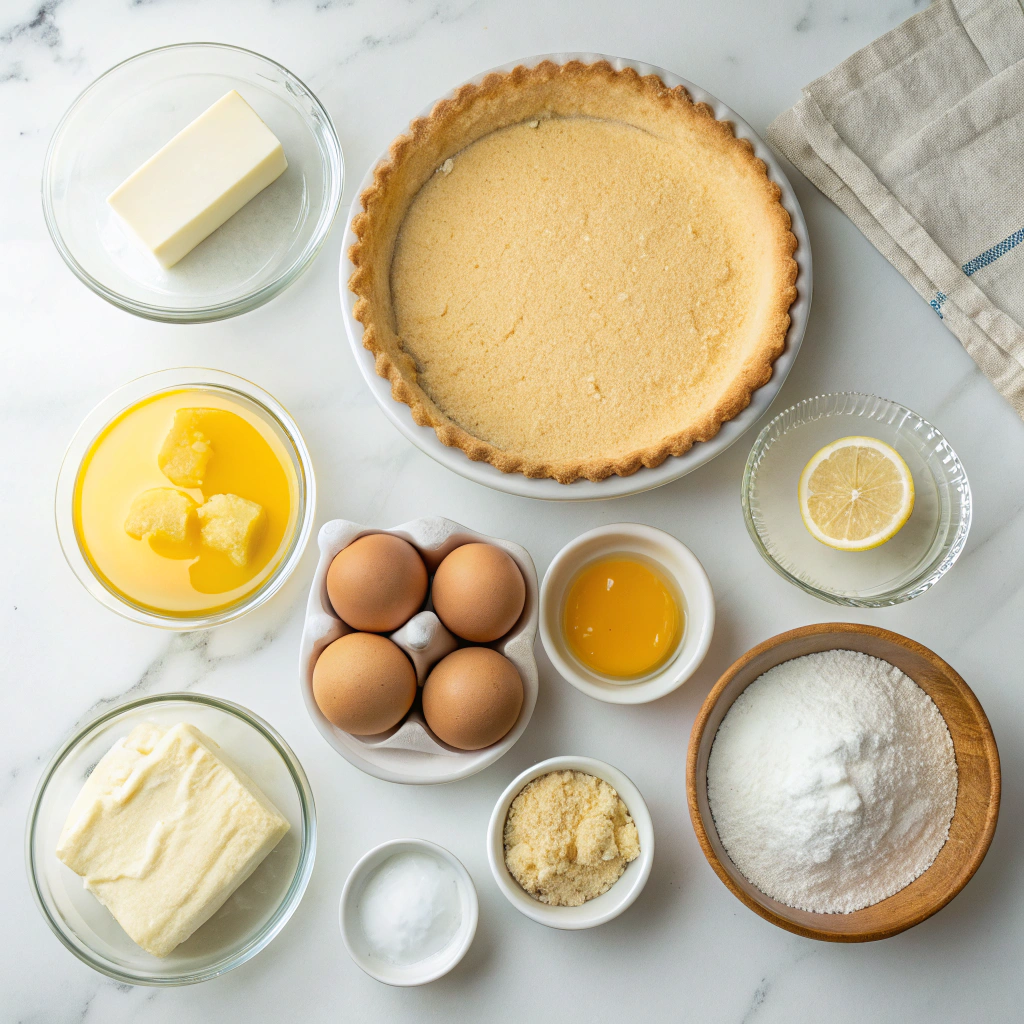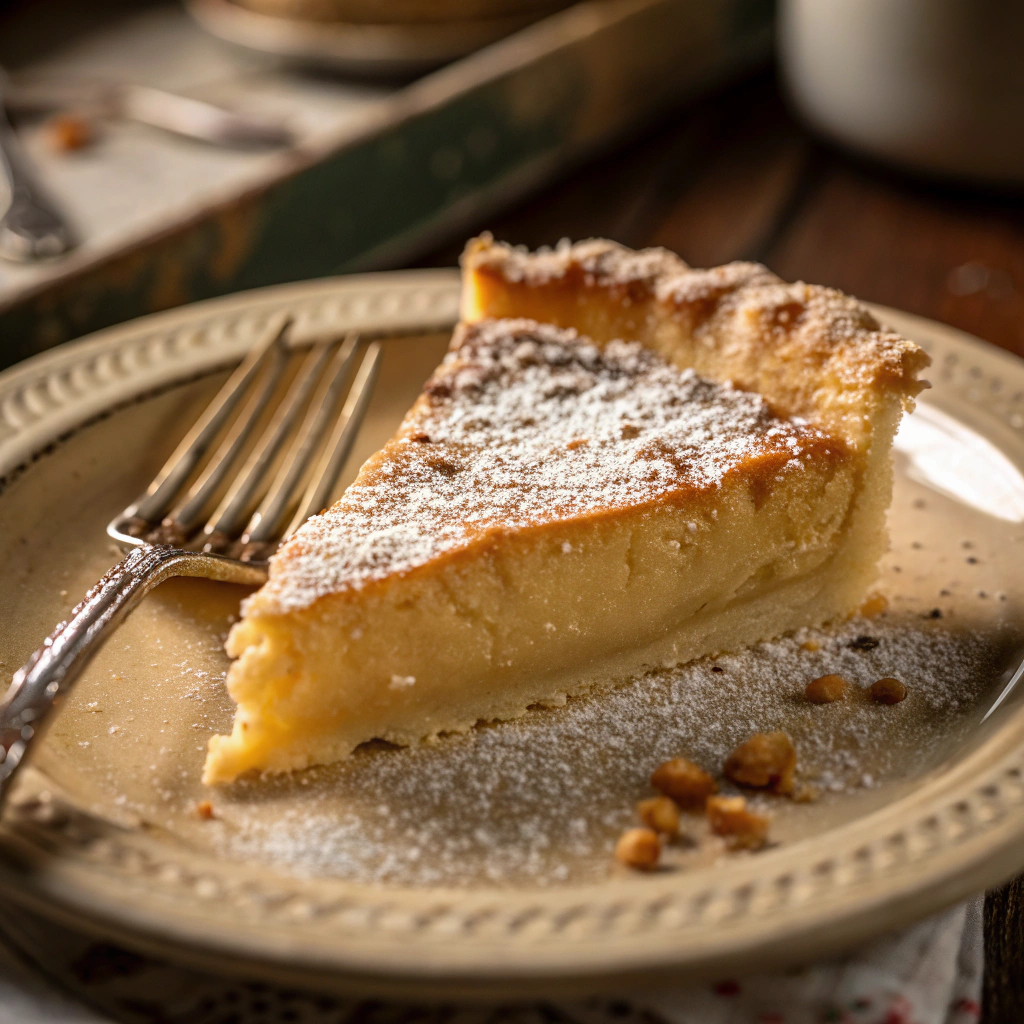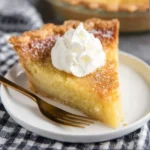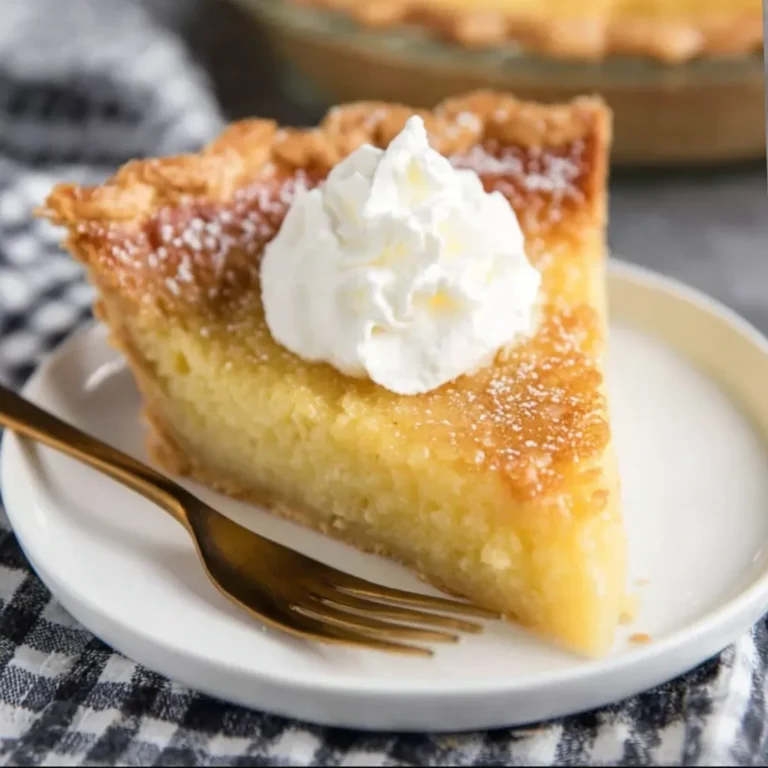Chess pie embodies Southern baking ingenuity—transforming simple pantry staples into a beloved dessert that has graced family tables for generations. This quintessential Southern chess pie recipe represents more than just a sweet ending to a meal; it’s a testament to resourcefulness and tradition. Many home bakers struggle with achieving the ideal custard consistency and avoiding common baking flaws like cracked surfaces or runny centers. Our comprehensive guide will teach you foolproof techniques, professional troubleshooting tips, and cultural insights to master this classic Southern treat with confidence.
Table of Contents
What Makes Chess Pie a Southern Classic: Origins, Characteristics, and Cultural Significance
Historical Roots of Chess Pie
The origins of chess pie stretch back to the antebellum South, where resourceful cooks created magic from basic ingredients. While theories about the name vary—from “chest pie” stored in pie chests to “just pie” in Southern dialect—what remains constant is its role as a symbol of Southern hospitality. This humble dessert emerged from necessity, utilizing pantry staples like eggs, sugar, butter, and cornmeal when fresh fruits were scarce.
Unlike fruit pies that depended on seasonal availability, chess pie could be made year-round, making it a reliable comfort food during challenging times. The recipe traveled through generations via oral tradition, with each family adding their own subtle variations while maintaining the essential character that makes chess pie distinctively Southern.
Distinctive Features of Authentic Chess Pie
A traditional chess pie recipe distinguishes itself through several key characteristics that set it apart from other custard-based desserts. The signature element is cornmeal, which creates the pie’s characteristic texture—silky yet substantial, with a subtle grittiness that provides delightful contrast to the smooth custard base.

The filling achieves its distinctive consistency through careful balance of eggs, which provide structure and richness, while milk or cream adds smoothness. Unlike other custard pies, chess pie forms its own top crust during baking—a golden, slightly caramelized surface that develops naturally as the filling sets. Understanding the custard pie science behind this transformation helps bakers achieve consistent results.
Regional Variations and Cultural Importance
Across the South, chess pie variations reflect local preferences and available ingredients. Some regions prefer vanilla extract for flavoring, while others rely on fresh lemon juice and zest for brightness. Vinegar appears in certain traditional recipes, adding subtle tang that balances the pie’s sweetness. These regional differences showcase how this simple dessert adapted to local tastes while maintaining its essential identity.
Chess pie holds special significance in Southern culture, often appearing at church gatherings, family reunions, and holiday celebrations alongside other beloved desserts like sweet potato pie recipe and traditional layer cakes. Its presence at these occasions reinforces community bonds and preserves culinary heritage for future generations.
Essential Chess Pie Recipe Ingredients and Quality Guidelines
Core Ingredients for Perfect Chess Pie
Creating an exceptional chess pie begins with understanding each ingredient’s role and selecting the highest quality components. Fresh eggs serve as the foundation, providing both structure and richness—check the egg nutrition facts to understand their nutritional contribution to your dessert.
Essential ingredients include:
- Eggs (4-5 large): Use room temperature eggs for better incorporation and smoother texture
- Granulated sugar (1½ cups): Provides sweetness and helps create the characteristic top crust
- Unsalted butter (½ cup): Adds richness and contributes to the silky mouthfeel
- Yellow cornmeal (2 tablespoons): Creates the signature texture that distinguishes chess pie from other custard pies
- All-purpose flour (1 tablespoon): Helps stabilize the filling and prevent separation
- Whole milk (⅓ cup): Provides creaminess and helps achieve proper consistency
- Pure vanilla extract (1 teaspoon): Enhances flavor complexity
- Fresh lemon juice and zest: Adds brightness and balances sweetness
Ingredient Substitutions and Quality Tips
While traditional chess pie recipes work best with specified ingredients, understanding substitutions helps accommodate dietary needs and ingredient availability. For the cornmeal, fine-ground yellow cornmeal produces the smoothest texture, though medium-grind creates more pronounced texture contrast.
Butter substitutions require careful consideration—European-style butter with higher fat content enhances richness, while plant-based alternatives may slightly alter texture and flavor. When selecting vanilla extract, pure vanilla provides superior flavor compared to imitation versions, though the difference becomes subtle after baking.
For those managing dietary restrictions, whole milk can be replaced with heavy cream for richer results or reduced-fat milk with minimal texture changes. However, avoid non-dairy milk alternatives as they may affect the custard’s setting properties.
Step-by-Step Chess Pie Recipe Instructions
Preparing Your Pie Crust Foundation
Success with any chess pie recipe begins with a properly prepared crust. Whether using homemade pastry or store-bought options, the crust must be pre-baked to prevent soggy bottoms. Follow expert guidance from this perfect pie crust guide for professional results.
Roll your pastry to 12-inch diameter and carefully transfer to a 9-inch pie plate. Trim edges leaving 1-inch overhang, then fold under and crimp decoratively. Pierce the bottom with a fork and line with parchment paper and pie weights. Pre-bake at 375°F for 12-15 minutes until edges are lightly golden.
Creating the Perfect Chess Pie Filling
The key to smooth, lump-free chess pie filling lies in proper mixing technique and ingredient temperature. Begin by whisking eggs thoroughly in a large bowl until well combined but not frothy. Gradually add sugar while whisking continuously to prevent graininess.
Step-by-step mixing process:
- Melt butter and let cool slightly to prevent cooking the eggs
- Whisk cornmeal and flour together to eliminate lumps
- Add cooled melted butter to egg mixture slowly while whisking
- Incorporate cornmeal-flour mixture until smooth
- Add milk, vanilla, lemon juice, and zest
- Whisk until completely smooth and well combined
Strain the filling through fine-mesh sieve to ensure silky texture and remove any remaining lumps. This professional technique elevates homemade chess pie to bakery-quality standards.
Baking Techniques for Optimal Results
Proper baking technique determines whether your chess pie achieves the ideal texture or suffers from common problems like cracking or uneven setting. Preheat oven to 350°F and position rack in lower third of oven for even bottom cooking.
Pour strained filling into pre-baked crust and bake for 45-55 minutes until center is almost set but still slightly jiggly. The surface should develop a beautiful golden color with possible light cracking—this is normal and desirable. Avoid overbaking as residual heat will continue cooking the custard.
Professional Chess Pie Troubleshooting and Expert Tips
Common Chess Pie Problems and Solutions
Even experienced bakers encounter challenges when perfecting their chess pie recipe. Understanding common issues and their solutions helps achieve consistent results every time. Cracked surfaces often result from temperature shock or overbaking—to prevent this, avoid opening the oven door during baking and test doneness carefully.
Runny filling typically indicates underbaking or incorrect ingredient ratios. If your pie appears too liquid after cooling, the eggs haven’t properly set the custard. Next time, bake an additional 5-10 minutes until the center barely jiggles when gently shaken.
Curdled or grainy texture usually stems from adding hot butter to eggs too quickly or using eggs straight from the refrigerator. Always let eggs reach room temperature and cool melted butter slightly before combining.
Texture and Consistency Mastery
Achieving the perfect chess pie texture requires understanding visual and tactile cues during preparation and baking. The finished filling should create a smooth ribbon when lifted with a whisk, indicating proper emulsification of ingredients.
During baking, watch for the characteristic golden-brown surface that develops as natural sugars caramelize. The center should appear almost set with just a hint of movement when the pie plate is gently shaken. Remember that chess pie continues cooking from residual heat even after removal from the oven.
Chess Pie Variations and Creative Adaptations
Traditional Flavor Variations
While classic chess pie stands beautifully on its own, traditional variations add exciting flavor dimensions. Chocolate chess pie incorporates cocoa powder for rich depth, while coconut chess pie features shredded coconut and coconut extract for tropical appeal.
Lemon chess pie intensifies citrus flavors with additional lemon juice and zest, creating a brighter, more acidic profile that balances the pie’s inherent sweetness. These variations maintain the essential texture and character while offering different flavor profiles for diverse preferences.
Modern Creative Adaptations
Contemporary bakers have embraced chess pie’s versatility, creating innovative adaptations that honor tradition while embracing modern tastes. Individual chess pie tarts offer elegant presentation for special occasions, while chess pie bars provide portable convenience for casual gatherings.
Seasonal variations might include pumpkin spice chess pie for autumn celebrations or fresh berry swirls for summer entertaining. These creative adaptations demonstrate how this traditional Southern dessert continues evolving while maintaining its essential character. Like other beloved Southern desserts such as vanilla butter cake and buttermilk pound cake, chess pie adapts beautifully to modern preferences while preserving its cultural significance.
Frequently Asked Questions About Chess Pie
What are the key ingredients for a traditional Southern chess pie and how can I substitute them if needed?
Traditional chess pie requires eggs, sugar, butter, cornmeal, flour, milk, vanilla, and lemon. Key substitutions include using European butter for richer flavor, heavy cream instead of milk for more luxurious texture, or fine cornmeal for smoother consistency. However, cornmeal remains irreplaceable as it creates the characteristic texture that distinguishes chess pie from regular custard pies.
How long should I bake my chess pie recipe for perfect results?
Bake chess pie at 350°F for 45-55 minutes until the center is almost set with just slight jiggle. Overbaking causes cracking and rubbery texture, while underbaking results in runny filling. The surface should develop golden-brown color naturally during baking, indicating proper caramelization.
Why did my chess pie crack and how can I prevent this?
Chess pie cracking typically results from rapid temperature changes, overbaking, or oven temperature fluctuations. Prevent cracking by maintaining consistent oven temperature, avoiding door opening during baking, and removing the pie when center still slightly jiggles. Light surface cracks are actually normal and add to the pie’s rustic charm.
What’s the difference between chess pie and other custard-based Southern desserts?
Chess pie distinguishes itself through cornmeal inclusion, which creates unique texture, and its ability to form a natural top crust during baking. Unlike smooth custard pies, chess pie has subtle grittiness and more substantial mouthfeel. The cornmeal and traditional preparation method make it distinctly Southern compared to French-influenced custard desserts.
How should I store chess pie and how long does it stay fresh?
Store chess pie covered in the refrigerator for up to 4 days. The pie actually improves after overnight chilling as flavors meld and texture fully sets. Serve at room temperature for best flavor, removing from refrigeration 30 minutes before serving. Chess pie freezes well for up to 3 months when properly wrapped.
Can I make chess pie ahead for special occasions?
Chess pie is ideal for advance preparation as it requires complete cooling and benefits from overnight chilling. Prepare up to 2 days ahead and store refrigerated. This makes it perfect for holiday celebrations, family gatherings, and entertaining when time management is crucial.

Mastering this chess pie recipe connects you to generations of Southern baking tradition while providing a reliable, delicious dessert for any occasion. The beauty of chess pie lies in its simplicity—transforming basic pantry ingredients into something truly special through proper technique and understanding. With the troubleshooting tips, cultural context, and variations provided, you’re equipped to create chess pies that honor tradition while satisfying modern palates. Whether serving this classic at family gatherings or introducing friends to Southern baking heritage, your homemade chess pie will create lasting memories and perhaps inspire the next generation of bakers to continue this beloved culinary tradition.
chess pie recipe
Print
Chess Pie Recipe: 5 Incredible Secrets That Will Perfect Your Southern Classic
- Total Time: 3 hours 30 minutes (including cooling)
- Yield: 8 servings 1x
- Diet: Vegetarian
Description
Step into Southern baking tradition with this absolutely divine Classic Chess Pie that’s pure comfort food magic! This legendary dessert features a silky, sweet custard filling with the perfect hint of cornmeal texture, all nestled in a flaky, golden crust. With its rich, buttery flavor and bright lemon finish, this timeless pie has been gracing Southern tables for generations—and once you taste it, you’ll understand why. Simple pantry ingredients transform into something truly extraordinary, making this the perfect dessert for family gatherings, potluck dinners, or anytime you want to create a little Southern hospitality!
Ingredients
- 1 unbaked pie crust (store-bought or homemade)
- 1 stick (8 tablespoons) unsalted butter, melted
- 2 cups granulated sugar
- 4 large eggs, at room temperature
- 3 tablespoons yellow cornmeal
- 1 tablespoon all-purpose flour
- ¼ cup whole milk, at room temperature
- 1½ tablespoons fresh lemon juice
- 1 teaspoon pure vanilla extract
- Pinch of salt
- Powdered sugar for dusting (optional)
Instructions
- Prep Your Pie Foundation: Preheat oven to 375°F (190°C). Roll pie crust into a 12-inch circle on a lightly floured surface, then transfer to a 9-inch pie plate (no deeper than 1¼ inches). Tuck edges under and crimp beautifully. Freeze for 20 minutes to prevent shrinkage.
- Blind Bake to Perfection: Prick the frozen crust bottom 8-10 times with a fork. Line with parchment paper, fill with pie weights, and place on a rimmed baking sheet. Bake 10-12 minutes until edges are dry.
- Finish the Crust: Carefully remove parchment and weights. Return to oven and bake 3-5 minutes more until bottom is dry and edges are light golden brown. Cool slightly, then reduce oven temperature to 350°F (175°C).
- Create the Legendary Filling: In a medium bowl, whisk melted butter and sugar until smooth and glossy. Add eggs one at a time, whisking well after each addition to create that perfect custard base.
- Add the Classic Touch: Whisk in cornmeal and flour until just combined—this gives chess pie its signature texture! Then add milk, fresh lemon juice, vanilla, and salt, mixing until the filling is silky smooth.
- Bake to Golden Glory: Pour filling into the prepared crust and bake 45-50 minutes until edges and center are completely set. If the crust or surface browns too quickly, tent with foil during the last 15 minutes.
- Cool and Serve with Pride: Let pie cool completely for about 2 hours—this allows the custard to set to perfection. Dust with powdered sugar before serving for that beautiful finishing touch that makes every slice special!
Notes
The secret to perfect chess pie is patience—let it cool completely for the ideal custard texture! The cornmeal is what distinguishes chess pie from other custard pies, giving it that characteristic slightly grainy texture that’s absolutely delicious. Room temperature eggs and milk blend more smoothly for the silkiest filling. Fresh lemon juice is essential for that bright flavor that balances the rich sweetness. This pie actually improves with time—it’s even better the next day! Store covered in the refrigerator for up to 4 days. Serve at room temperature for the best flavor and texture.
- Prep Time: 30 minutes
- Cook Time: 1 hour
- Category: Dessert
- Method: Baking
- Cuisine: Southern American
Nutrition
- Serving Size: 1 slice (1/8 of pie)
- Calories: 485
- Sugar: 54g
- Sodium: 295mg
- Fat: 20g
- Saturated Fat: 11g
- Unsaturated Fat: 9g
- Trans Fat: 0g
- Carbohydrates: 75g
- Fiber: 1g
- Protein: 7g
- Cholesterol: 135mg
Keywords: chess pie, southern dessert, custard pie, traditional pie, classic southern recipe

